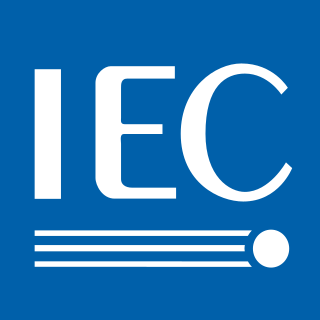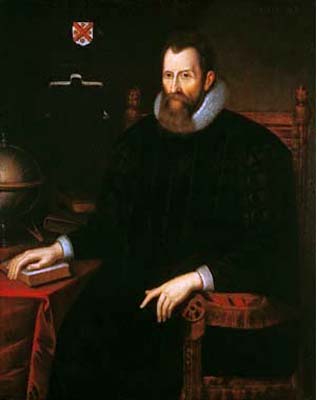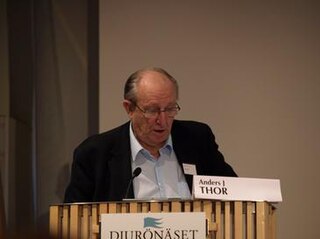Related Research Articles
The byte is a unit of digital information that most commonly consists of eight bits. Historically, the byte was the number of bits used to encode a single character of text in a computer and for this reason it is the smallest addressable unit of memory in many computer architectures. To disambiguate arbitrarily sized bytes from the common 8-bit definition, network protocol documents such as The Internet Protocol refer to an 8-bit byte as an octet. Those bits in an octet are usually counted with numbering from 0 to 7 or 7 to 0 depending on the bit endianness. The first bit is number 0, making the eighth bit number 7.
A binary prefix is a unit prefix for multiples of units. It is most often used in data processing, data transmission, and digital information, principally in association with the bit and the byte, to indicate multiplication by a power of 2. As shown in the table to the right there are two sets of symbols for binary prefixes, one set established by International Electrotechnical Commission (IEC) and several other standards and trade organizations using two-letter symbols, e.g. Mi indicating 1048576 with a second set established by semiconductor industry convention using one-letter symbols, e.g., M also indicating 1048576.
Giga ( or ) is a unit prefix in the metric system denoting a factor of a short-scale billion or long-scale milliard (109 or 1000000000). It has the symbol G.

The International Electrotechnical Commission is an international standards organization that prepares and publishes international standards for all electrical, electronic and related technologies – collectively known as "electrotechnology". IEC standards cover a vast range of technologies from power generation, transmission and distribution to home appliances and office equipment, semiconductors, fibre optics, batteries, solar energy, nanotechnology and marine energy as well as many others. The IEC also manages four global conformity assessment systems that certify whether equipment, system or components conform to its international standards.
The kilobyte is a multiple of the unit byte for digital information.
The kilobit is a multiple of the unit bit for digital information or computer storage. The prefix kilo- (symbol k) is defined in the International System of Units (SI) as a multiplier of 103 (1 thousand), and therefore,
The megabyte is a multiple of the unit byte for digital information. Its recommended unit symbol is MB. The unit prefix mega is a multiplier of 1000000 (106) in the International System of Units (SI). Therefore, one megabyte is one million bytes of information. This definition has been incorporated into the International System of Quantities.
A metric prefix is a unit prefix that precedes a basic unit of measure to indicate a multiple or submultiple of the unit. All metric prefixes used today are decadic. Each prefix has a unique symbol that is prepended to any unit symbol. The prefix kilo-, for example, may be added to gram to indicate multiplication by one thousand: one kilogram is equal to one thousand grams. The prefix milli-, likewise, may be added to metre to indicate division by one thousand; one millimetre is equal to one thousandth of a metre.

The neper is a logarithmic unit for ratios of measurements of physical field and power quantities, such as gain and loss of electronic signals. The unit's name is derived from the name of John Napier, the inventor of logarithms. As is the case for the decibel and bel, the neper is a unit defined in the international standard ISO 80000. It is not part of the International System of Units (SI), but is accepted for use alongside the SI.
ISO 31 is a superseded international standard concerning physical quantities, units of measurement, their interrrelationships and their presentation. It was revised and replaced by ISO/IEC 80000.
ISO 31-0 is the introductory part of international standard ISO 31 on quantities and units. It provides guidelines for using physical quantities, quantity and unit symbols, and coherent unit systems, especially the SI. It is intended for use in all fields of science and technology and is augmented by more specialized conventions defined in other parts of the ISO 31 standard. ISO 31-0 was withdrawn on 17 November 2009. It is superseded by ISO 80000-1. Other parts of ISO 31 have also been withdrawn and replaced by parts of ISO 80000.
Typographical conventions in mathematical formulae provide uniformity across mathematical texts and help the readers of those texts to grasp new concepts quickly.
IEEE 1541-2002 is a standard issued in 2002 by the Institute of Electrical and Electronics Engineers (IEEE) concerning the use of prefixes for binary multiples of units of measurement related to digital electronics and computing.
The octet is a unit of digital information in computing and telecommunications that consists of eight bits. The term is often used when the term byte might be ambiguous, as the byte has historically been used for storage units of a variety of sizes.
ISO 80000 or IEC 80000 is an international standard introducing the International System of Quantities (ISQ). It was developed and promulgated jointly by the International Organization for Standardization (ISO) and the International Electrotechnical Commission (IEC).
The JEDEC memory standards are the specifications for semiconductor memory circuits and similar storage devices promulgated by the Joint Electron Device Engineering Council (JEDEC) Solid State Technology Association, a semiconductor trade and engineering standardization organization.
The International System of Quantities (ISQ) consists of the quantities used in physics and in modern science in general, starting with basic quantities such as length and mass, and the relationships between those quantities. This system underlies the International System of Units (SI) but does not itself determine the units of measurement used for the quantities. It is inherently incomplete because the number of quantities is potentially infinite.
In telecommunications, data-transfer rate is the average number of bits (bitrate), characters or symbols (baudrate), or data blocks per unit time passing through a communication link in a data-transmission system. Common data rate units are multiples of bits per second (bit/s) and bytes per second (B/s). For example, the data rates of modern residential high-speed Internet connections are commonly expressed in megabits per second (Mbit/s).
IEC Technical Committee 25, "Quantities and units, and their letter symbols", was established in 1935. It is one of the technical committees of the International Electrotechnical Commission (IEC).

Anders Johan Thor (1935–2012) was a Swedish scientist and teacher most notable for his leadership in international standardization of quantities and units. He is one of the creators of binary prefixes and the IUPAC Green Book.
References
- ↑ "1996 IUCr IUPAC Interdivisional Committee on Nomenclature and Symbols (IDCNS) report". Chester.iucr.org. Archived from the original on 2013-06-13. Retrieved 2012-01-26.
- ↑ "These prefixes for binary multiples, which were developed by IEC Technical Committee (TC) 25, Quantities and units, and their letter symbols, with the strong support of the International Committee for Weights and Measures (CIPM) and the IEEE, were adopted by the IEC as Amendment 2 to IEC International Standard IEC 60027-2: Letter symbols to be used in electrical technology – Part 2: Telecommunications and electronics."
- ↑ "IUCR 1999 report on IUPAC Interdivisional Committee on Nomenclature and Symbols". Journals.iucr.org. Retrieved 2012-01-26.
- ↑ IEC 60027-2 (2000-11) Ed. 2.0
- ↑ Thor, A. J. (2000). "Prefixes for binary multiples" (PDF). Metrologia. 37 (81): 81. Bibcode:2000Metro..37...81T. doi:10.1088/0026-1394/37/1/12. S2CID 250774728.[ permanent dead link ]
- ↑ "HERE COME ZEBI AND YOBI" (Press release). International Electrotechnical Commission. 2005-08-15. Archived from the original on September 12, 2009.
- ↑ "niso, New Specs and Standards". Niso.org. Archived from the original on 2008-12-08. Retrieved 2012-01-26.